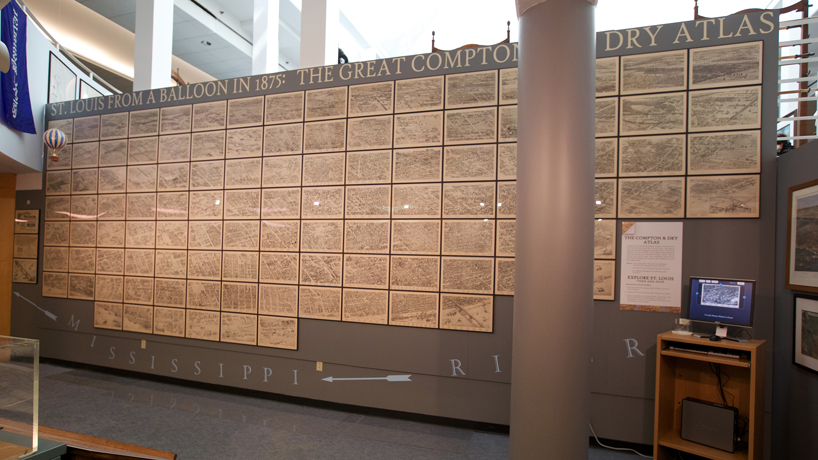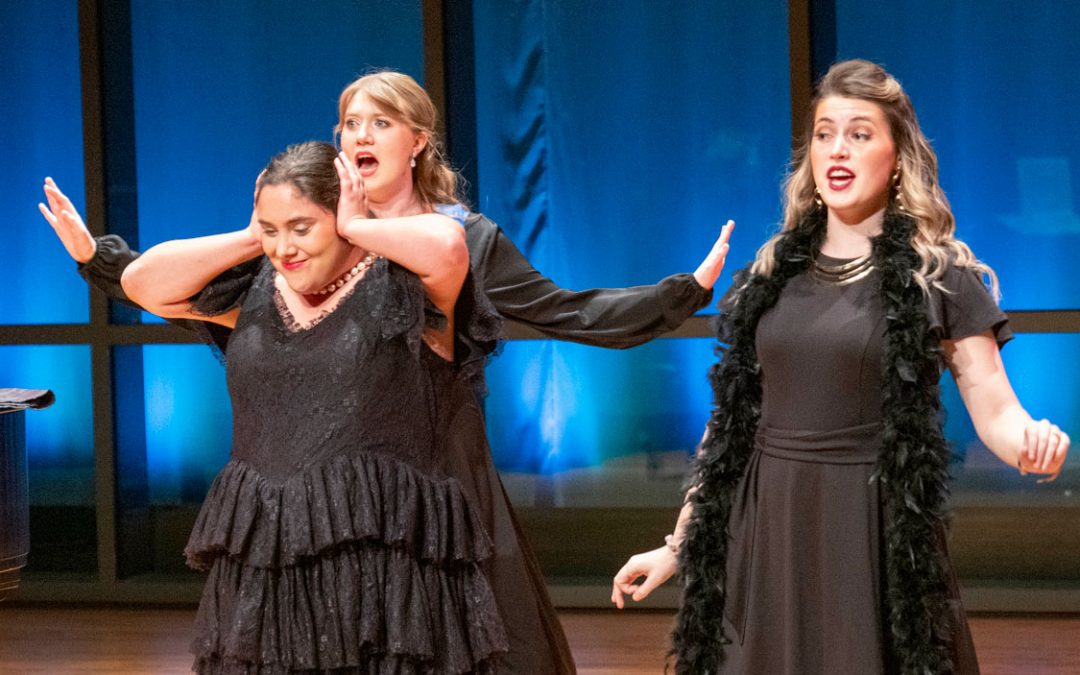
This 30-foot-wide view of St. Louis from 1875 is part of “Mapping St. Louis History,” an exhibition at the St. Louis Mercantile Library. (Photos by August Jennewein)
For one of the oldest cultural institutions west of the Mississippi, it’s been an eventful year marked by milestones and more visitors than ever.
On Oct. 20, the St. Louis Mercantile Library at the University of Missouri–St. Louis unveiled its latest major effort in celebration of St. Louis’ 250th birthday: a vast exhibition that tells the city’s story through several centuries’ worth of maps.
Beginning with the earliest known example of the words “St. Louis” printed on a map, “Mapping St. Louis History: An Exhibition of Historic Maps, Rare Books and Images Commemorating the 250th Anniversary of the Founding of St. Louis” explores wide-ranging aspects of the city’s development.
It’s the culmination of many months of preparation by the Mercantile staff and will remain on display through June, free and open to the public during library hours.
For John Hoover, director of the Mercantile Library, the exhibition is also the fulfillment of an idea that originated long ago but was finally feasible in the library’s current location at UMSL.
Hoover, who is in his 30th year leading the Mercantile, spoke with UMSL Daily about a few of the show’s highlights, his passion for the Mercantile and the people it serves.
What’s the story behind the 30-foot-wide aerial view of the city from 1875?
“Pictorial St. Louis” is one of the greatest views in detail of an American city produced in any age. It was done through detailed drafting in a balloon and subsequent, painstaking lithography on the ground – and was an extraordinary work of engineering and art that digital mapping is only now catching up with.
The scale of this ambitious work has never been fully duplicated, and it has almost an international cult of enthusiasts. It is one of the greatest books printed in our region and is still used by historians, genealogists, librarians and many others for its riveting clarity and impressive scale.
A fine donor loaned a copy that he wished to see framed on one wall on behalf of this exhibition. The Mercantile is digitizing one of its own copies for the Missouri Digital Library under a special grant to make it available in this fashion, completely and accurately, for the first time online.
This major exhibition sounds impressive, with materials ranging from centuries-old maps of St. Louis to contemporary satellite imagery. Can you share a little bit about the process of curating it and putting all of this together? What was that like?
This exhibition was one I always wanted to attempt, but maps, because of their size or fragility, are hard to exhibit in conventional cases, so it took years before we could attempt it. To be able to present this show effectively also had a lot to do with the Mercantile’s coming to UMSL. In the fine space we now occupy, this interactive show became possible.
Our staff put everything it has learned from years of presenting local and traveling exhibitions to bear on this show. Maps came out of drawers, cabinets and the rare book vault in a two-year-long selection process that included writing a catalogue arranged in a way that I hope will aid future Mercantile Library curators in organizing and caring for this great collection across the many subjects the library holds.
Without giving too much away, how does the story of St. Louis come to life in “Mapping St. Louis History,” and are there moments that stand out to you in a new way?
The immediate theme of these five centuries of maps is the great confluence of the greatest American rivers, which St. Louis stands astride. In some ways there was St. Louis in thought before there was a St. Louis in actuality.
So many maps use the confluence of our region in the early years of maps of this continent as a central point. Clearly kings, merchants, explorers, settlers knew of this land, just like the ancient and vanished native cultures who lived here had, and their eyes were on it when the time was right to cut the first trees and build the first forts and trading posts.
That is a north-south story of the rivers. But the east-west story of St. Louis – a place name on any later map, from William Clark’s great maps to those of railroad developers, travelers, merchants and traders – reveals St. Louis as the beginning point, the point of departure graphically. For any St. Louisan, these maps are a source of the greatest pride in our living with and constantly influencing national events of great importance.
Along with commemorating St. Louis’ 250th birthday this year, the Mercantile is celebrating your 30 years of service to the library. (Congratulations!) What have you enjoyed most about your work in that time?
I have enjoyed building the collections of the library more than anything. Working with a legendary collection, and hoping that I can pass it down to future students here at UMSL in even greater depth, is something that makes me jump out of bed each day with the same enthusiasm I had my first day at work here all those years ago.
Nothing pleases me more than to see our collections cited nationally, as well as being used locally by our students. The days when I see the students using our resources and, yes, viewing the exhibitions in groups and in individual, reflective moments are the very best days indeed that any curator here at the Mercantile could possibly have.
Editor’s note: Free public tours of the exhibition are at 11 a.m. on Saturdays and 2 p.m. on Sundays. Group tours for adults and school groups may also be arranged. And save the date for other related events including Coffee in the Gallery with John Hoover from 10 a.m. to noon Jan. 16 and a family-day event, Mapping Your St. Louis, on March 15 (time still to be determined). For more information, see umsl.edu/mercantile or call 314-516-7248.
Media Coverage:
St. Louis Post-Dispatch

















